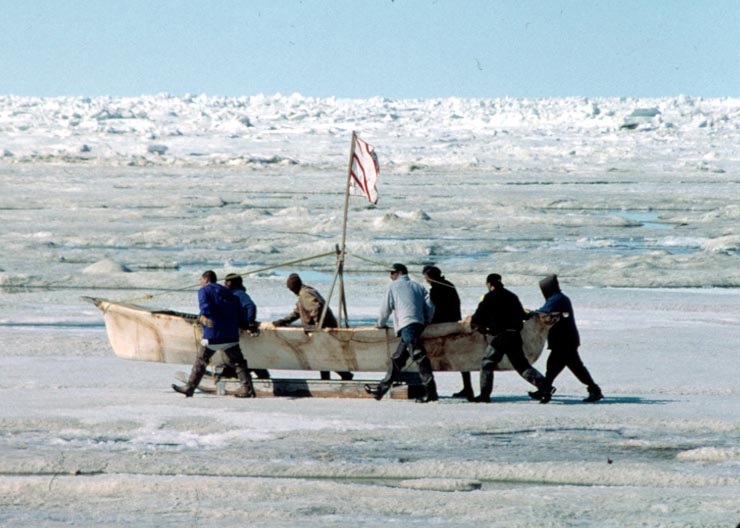|

When the spring came, the snow melted,
the whales came north and the geese flew over our lands.
We knew there would come a scientist or two to dig around and
ask us questions. They would stay about as long as the geese
did. The only difference was, we hated to see the geese
leave.
In the Native community, we sort of feel the same way about
eco-tourism. We walk that fine line of navigating between
the ideals of development (which would lead one to advocate rural
tourism), and the ideals of cultural tradition and integrity (which
might lead one to reject rural tourism). We share this ambivalence,
but recognize that these two conflicting ideals are connected
with the ongoing dynamics of cultures and communities with moral,
political, economic and ecological forces historically at work.
We might call these dynamics a cultural process, but one which
requires sensitivity and discussion in order to develop sustainable
tourism in rural Alaska only where it is truly desired within
the community.
There is at present an acknowledged need for examining the
impacts of cultural tourism on the social dynamics of rural communities
in Alaska and similar indigenous communities elsewhere.
Governor Knowles' Marketing Alaska Tourism Sector Working Group
acknowledges the need to assist rural communities in understanding
the potential as well as the ramifications of tourism in their
communities.
A recent publication on eco-tourism planning in Alaska states
that similar analysis and planning are needed to ensure the eco-tourism
is compatible with the way of life and cultural values of rural
residents.
Yet there is very little accessible, non-academic material
that addresses the issue.
Perhaps we can begin this dialogue today. We can start
the discussion by defining eco-tourism. We would define
it as being cultural as well as a wilderness experience and we
can identify two types of eco-tourism:
- Consumptive (hunting, fishing)
- Excursive or adventure (Hard, days/weeks rafting , kayaking
or Soft, hour/half-day river trip)
The cultural experience is generally the excursion type
- a half to whole day. Most adventures tend to be cultural
- tours run by non-Natives for non-Native visitors.
Natives are generally concerned about consumptive tourism,
not eco-tourism as usually defined. There are three major
areas of concern:
- Cultural
- Land leasing or crossing of Native lands (occurring mostly in
Bristol Bay area, some in Ahtna and in Southeast Alaska.
At present, Bristol Bay has the most eco-tourism going on.)
- Wildlife
There are four general categories of cultural tourism in
Alaska (all of which are tribally or community owned):
- Mature, cultural programs (1-2 day tours primarily in Arctic
- Barrow, Kotzebue, Nome)
- Small village add-ons to mature programs, e.g. to Gambell, Kiana
or Stevens Village (at the end of the haul road)
- Cultural performances as part of large city tour, e.g. Anchorage
Museum, Eklutna Village (near Anchorage), Juneau, Kodiak (Alutiiq
dancers), Fairbanks (Pioneer Park). This is a growing segment
of tourism.
- Eco-tourism, multi-day direct contact with community, flexible
schedules, e.g. St. Paul Island (3-6 day trips for wildlife viewing),
Afognak (archaeology digs), Huslia (tours that show the real village
setting, fish camp and let visitors hang out with locals)
A new category is just beginning to emerge:
- Private entrepreneurs (mostly non-Natives), e.g. in Southeast
Alaska, jet-boating along the Stikine River. These private
tours are mostly adventure-based tours (kayaking, canoeing, hiking).
So why are Native communities seeking tourism projects?
- Economic benefit - money. Although no one is getting rich.
- Preservation of culture - through creation of jobs for youth,
elders and the community; for performances/revitalization of dances,
songs, storytelling, making traditional dress; selling crafts;
education of community and visitors; training children; language
skills; self-esteem and pride in culture, and creation of long-term
benefits. Some are subsidized by their village corporations
or councils for these reasons.
- Local control - now communities can control who is running the
tours, hiring employees and presenting Native peoples and cultures
from their own perspective. This came about in Alaska only
recently because of an opportunity created when a large non-Native
owned organization went bankrupt and left tour operators without
local contracts. Many village communities stepped up and
continued operations on their own.
They were able to assert their principles of eco-tourism
to:
- Be respectful of local cultures
- Allow local communities to benefit financially from eco-tourism
This growing industry has brought about concerns of:
- Too many tourists (although this in not generally heard from
native communities)
- Tours staying out of small villages
Lets talk about the impacts of eco-tourism:
Positive:
- Native communities are learning the tourism business
- Some Native corporations are starting their own locally-owned
tours
- Communities have more control of the message getting out
- Big cruises/bus companies are using more guides for local tours
(Holland America and Princess)
- Big companies know it is good business to be a good citizen
and are helping to sell small village tours for local communities,
although private entrepreneurs are not.
Negative:
- Signs of severe impact on lands, tundra, vegetation
- Concerns with extraction
Primary Native Concerns:
- Use of lands without permission - issues of stress, waste, destruction
of river banks
- Access to subsistence harvests (moose, caribou) for locals -
traditional subsistence use areas are being over-used by large,
primarily non-Native cities like Anchorage, because of road access/systems.
Some corporations are now starting to charge for passage through
their lands in order to control their use.
We recognize two separate and distinct issues:
- Resource consumption issues and land control - because more
consumptive tourism is happening in areas like Bristol Bay and
Ahtna where there are not a lot of performance cultural activities
and they do not have the same issues as Southeast or the Arctic.
- Local control and jobs - more the issues in Southeast and the
Arctic where tourists are prevalent.
What are we in the Native community doing about these issues?
Communities and corporations are becoming more involved in the
planning, hiring and running of tours within their own areas.
-
Alaska Village Initiatives also manages the Rural Tourism Project,
a joint venture with the Alaska Division of Tourism, which helps
to connect local people with industry representative and presents
educational, business, planning, research and database workshops.
Native communities and organizations are also beginning
their own unique projects such as the work the Alaska Inter-Tribal
Council is doing with:
- Tourism on Kodiak Island - utilizing traditional knowledge to
apply to the growing tourism opportunities with the Kodiak Native
Tourism Association.
- Musk Ox at Mekoryuk on Nunivak Island - working with the Mekoryuk
Tribal Council to become co-managers with the U.S. Fish and Wildlife
Service of the largest federally-managed herd.
- Herring at Sitka Sound - The Sitka Tribe of Alaska is also seeking
to co-manage the herring sac roe fisheries in Sitka Sound with
the Alaska Department of Fish and Game. One of the concerns
is teaching people how to use traditional knowledge to collect
and record information which is essential to better understand
the herring fisheries within the last 100 years.
- Natural resources at Emmonak - working with their natural resource
specialist to identify how traditional methods can be utilized.
With all of this information, we have yet to determine the
real impacts of eco-tourism in village Alaska. In some
circumstances, conservation of wildlife and other natural resources
is viewed as antagonistic to economic development and improving
the economic lot of local areas and citizens. One manifestation
of that antagonism is that catering to tourism and natural resource
uses by nonresidents is sometimes viewed as selling out local
resources to the exclusion of local people. In other circumstances,
tourism is seen as a major source of jobs and income to local
economies and foreign exchange to national economies.
Whether any or all of those underlying premises are true or
not, the resource allocation issues arising from them are real.
However, the real questions of the impact of eco-tourism
in village Alaska remains: Who will gain, who will lose
and what does it mean?
|

